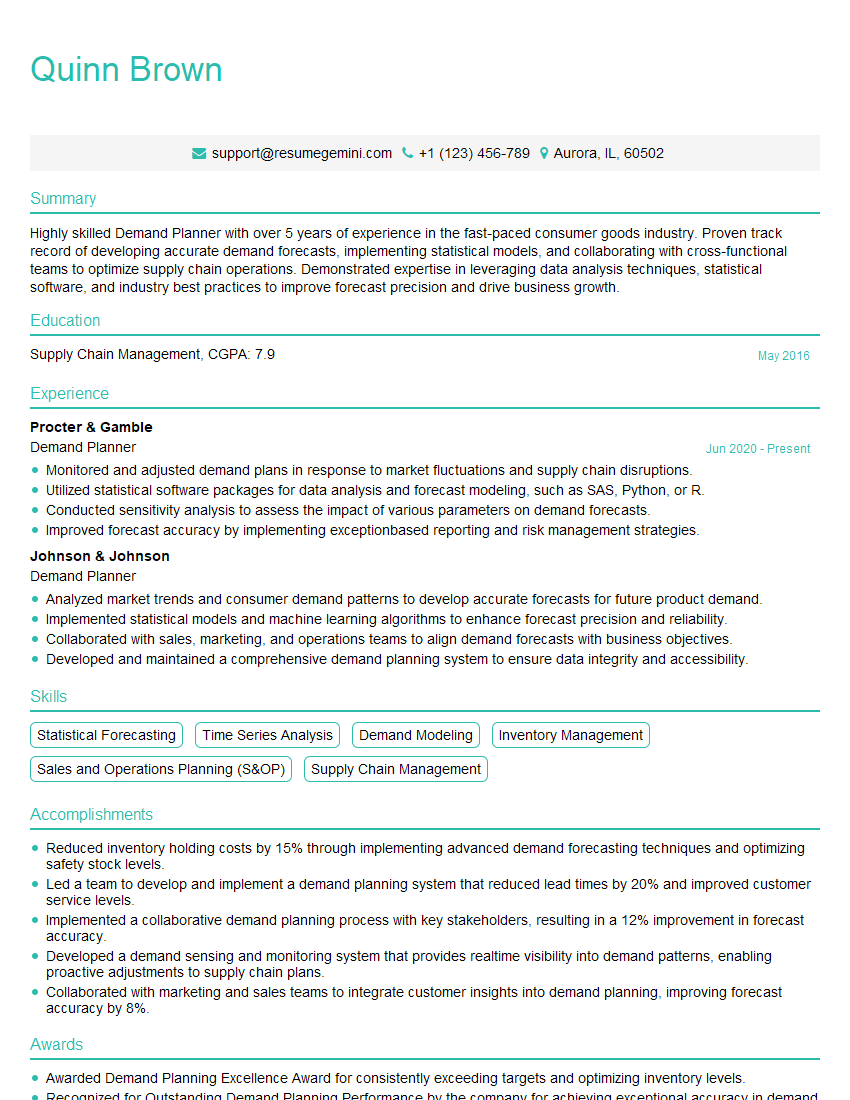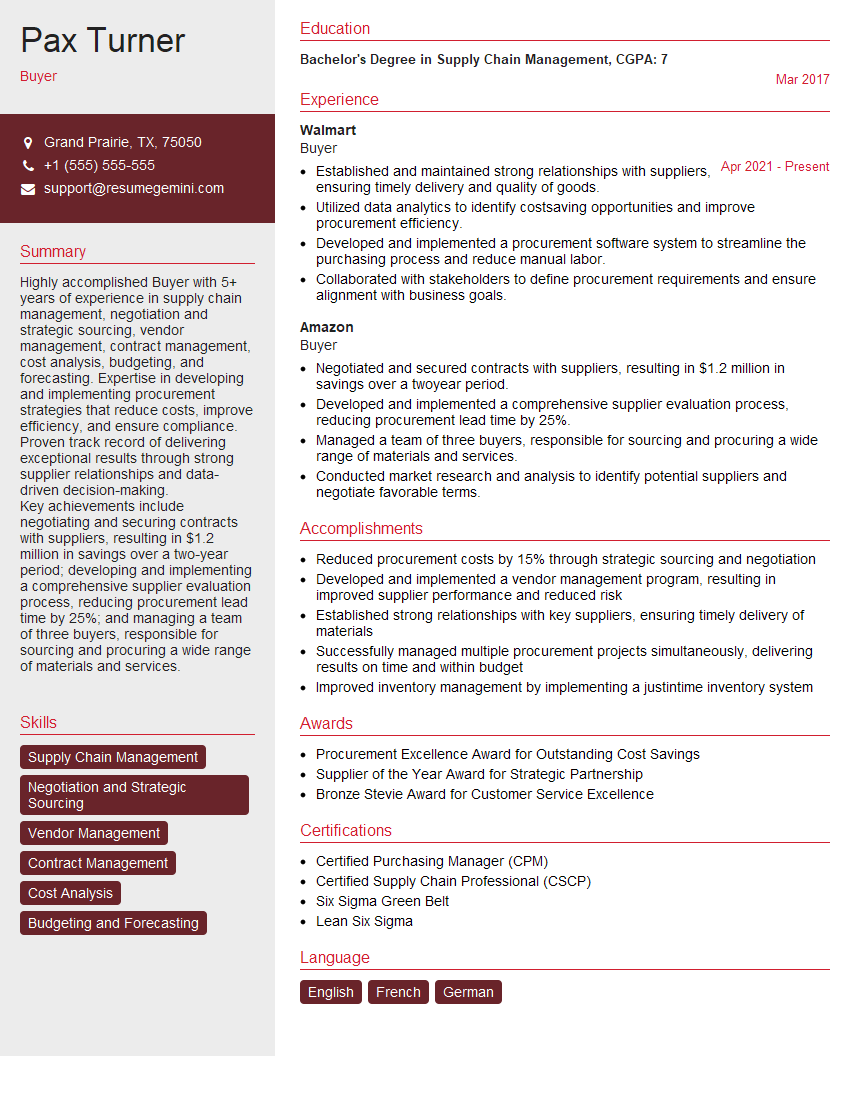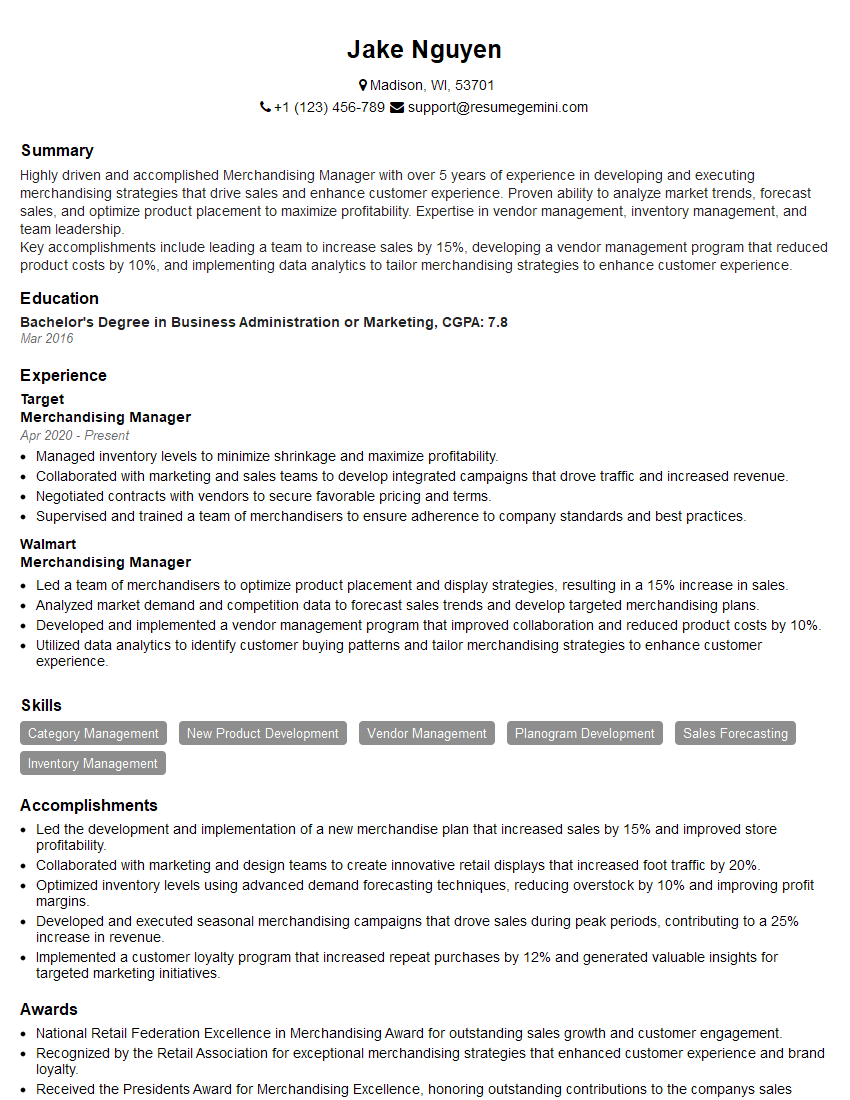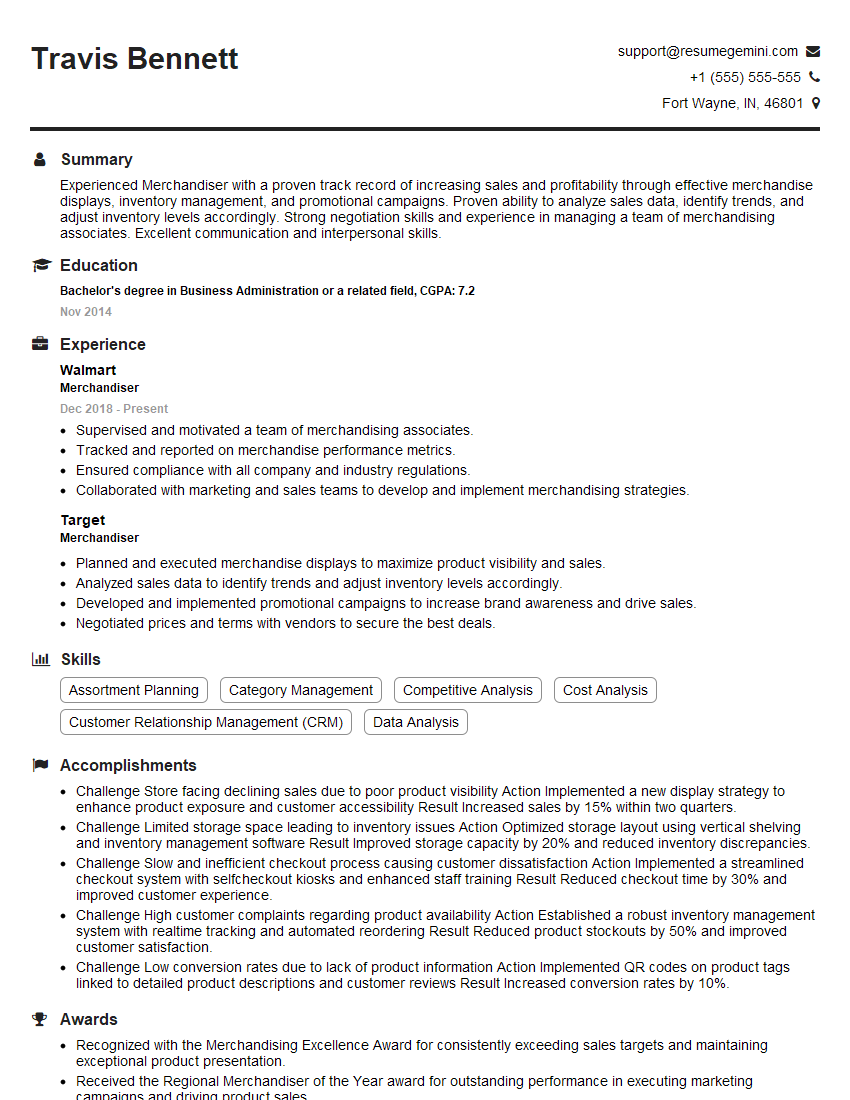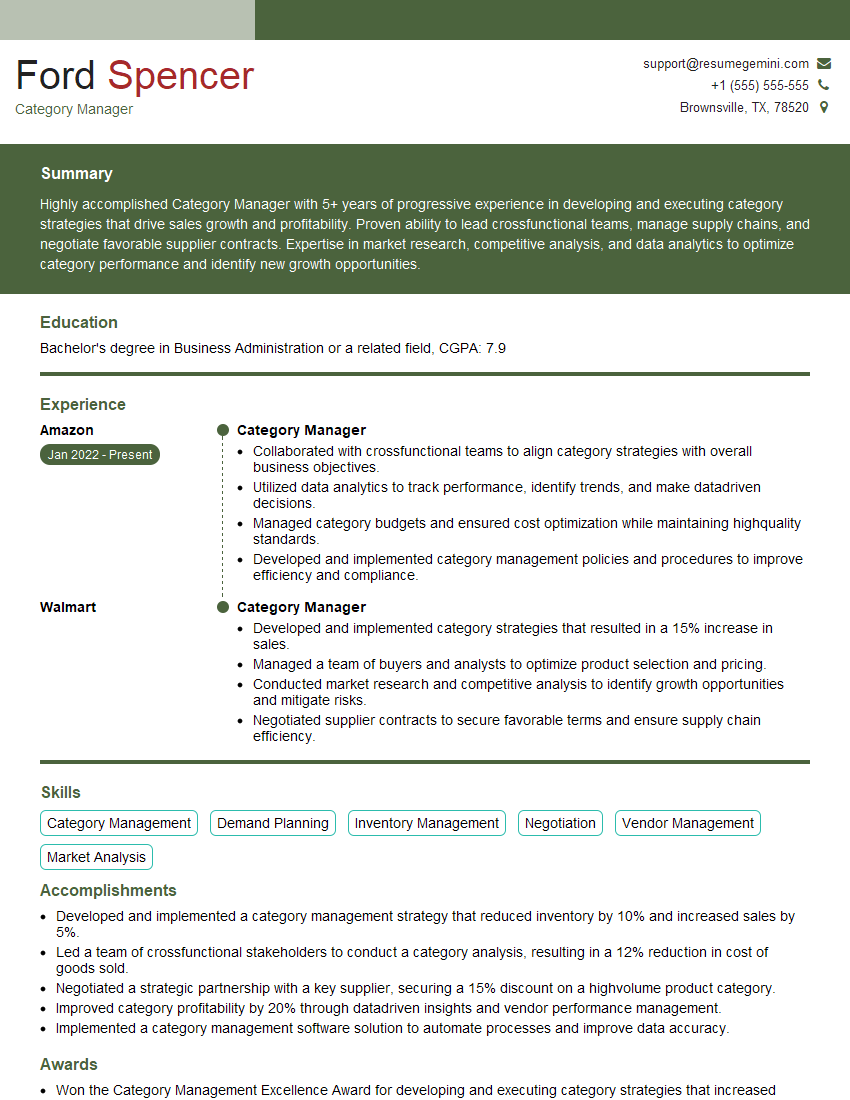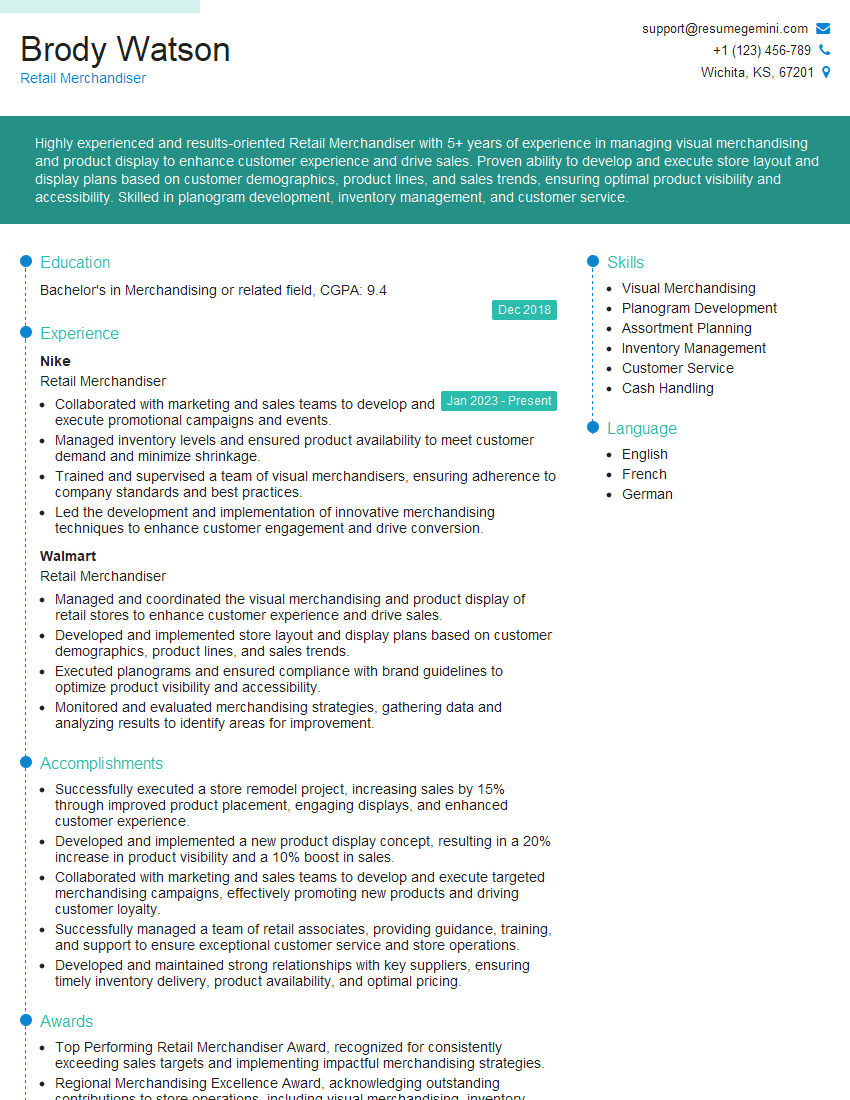Feeling uncertain about what to expect in your upcoming interview? We’ve got you covered! This blog highlights the most important Merchandising Principles interview questions and provides actionable advice to help you stand out as the ideal candidate. Let’s pave the way for your success.
Questions Asked in Merchandising Principles Interview
Q 1. Explain the concept of Open-to-Buy (OTB).
Open-to-Buy (OTB) is the amount of money a retailer has available to spend on new inventory within a given period, typically a month. It’s a crucial metric for managing inventory levels and ensuring profitability. Think of it like a budget specifically for purchasing new goods. It’s calculated by subtracting planned sales and markdowns from the beginning inventory plus planned purchases. This remaining amount represents the retailer’s purchasing power for new products.
Calculation: OTB = (Beginning Inventory + Planned Purchases) – (Planned Sales + Planned Markdowns)
Example: Let’s say a retailer starts the month with $100,000 in inventory and plans to purchase $50,000 more. They project $120,000 in sales and anticipate $10,000 in markdowns. Their OTB would be: ($100,000 + $50,000) – ($120,000 + $10,000) = $20,000. This means they have $20,000 available to buy new merchandise.
Effective OTB management prevents overstocking and ensures that the right amount of inventory is available to meet customer demand. It requires careful planning, accurate sales forecasting, and diligent tracking of inventory levels.
Q 2. How do you analyze sales data to inform merchandising decisions?
Analyzing sales data is critical for making informed merchandising decisions. I use a multi-faceted approach, starting with a detailed review of historical sales figures, broken down by product category, seasonality, and even individual items. I look for trends, identifying best-sellers, slow movers, and seasonal peaks and dips.
Beyond raw sales numbers, I delve into other metrics such as sell-through rate (percentage of inventory sold within a given period), average transaction value, and customer demographics associated with specific product purchases. This gives me a richer understanding of customer preferences and buying patterns.
Tools and Techniques: I leverage data visualization tools like dashboards and reporting software to identify key trends visually. For instance, a line graph showing sales trends over time can quickly reveal seasonal patterns. I also use statistical analysis to forecast future demand, incorporating factors like promotions, competitor activity, and economic indicators.
Example: If sales data reveals a consistent surge in demand for a particular dress style during the holiday season, I would adjust inventory levels and buying plans accordingly for the following year, potentially increasing the order quantities for that style in advance.
Q 3. Describe your experience with inventory management and control.
My experience with inventory management and control involves a systematic approach using both manual processes and sophisticated software. I utilize inventory management systems to track stock levels in real-time, ensuring accuracy and facilitating efficient replenishment.
Key Aspects: This includes regular stock counts, reconciliation with system data, and investigating discrepancies. I’m skilled at analyzing inventory turnover rates, identifying slow-moving items, and developing strategies for liquidating excess stock through markdowns or other promotional activities. I also employ forecasting techniques to predict future demand, helping to optimize inventory levels and prevent stockouts or overstocking.
Example: In a previous role, I implemented a cycle counting program, reducing inventory discrepancies by 15% and improving the accuracy of our stock data, leading to better informed purchasing decisions and reduced losses from stockouts or obsolescence.
I understand the importance of maintaining accurate inventory records to prevent shrinkage and improve profitability. I’m proficient in using various inventory management software to streamline processes.
Q 4. What are the key performance indicators (KPIs) you track in merchandising?
I track a variety of key performance indicators (KPIs) to assess the success of merchandising strategies. These KPIs are grouped into several categories:
- Sales Performance: Sales revenue, sell-through rate, gross margin, average transaction value, units per transaction.
- Inventory Management: Inventory turnover rate, stock-to-sales ratio, days of inventory on hand.
- Profitability: Gross margin return on investment (GMROI), contribution margin, markdown percentage.
- Customer Metrics: Customer acquisition cost, customer lifetime value, customer retention rate.
By monitoring these KPIs, I can identify areas for improvement, optimize pricing strategies, and make data-driven decisions to boost profitability and enhance customer satisfaction.
Example: A low sell-through rate might signal issues with pricing, product assortment, or marketing efforts, prompting a review of these aspects and necessary adjustments.
Q 5. How do you manage markdowns and promotions effectively?
Managing markdowns and promotions effectively requires a strategic approach, carefully balancing the need to clear out excess inventory with the goal of maintaining profitability. I avoid haphazard markdowns and instead use a data-driven approach.
Strategies: I analyze sales data to identify slow-moving items and determine appropriate markdown percentages. I often implement tiered markdowns, gradually reducing prices over time to maximize sales while minimizing losses. I also coordinate promotions with marketing campaigns to boost sales during specific periods.
Example: Instead of a blanket 50% markdown on all slow-selling items, I might start with a 20% markdown for the first week, increasing to 30% in the second week and 40% in the third week, depending on sales response. This allows me to gauge customer reactions and optimize the markdown strategy.
Careful planning and execution are crucial for success. I also factor in potential cannibalization effects on full-price sales when planning promotions.
Q 6. Explain your approach to forecasting demand.
My approach to forecasting demand combines quantitative and qualitative methods. I utilize historical sales data, analyzing trends, seasonality, and external factors such as economic conditions and competitor actions. I employ statistical forecasting techniques such as moving averages, exponential smoothing, or more sophisticated models based on specific data characteristics.
However, quantitative data alone isn’t sufficient. I also incorporate qualitative factors, such as upcoming marketing campaigns, new product launches, and industry trends gleaned from market research and industry publications. I often use collaborative forecasting approaches, engaging with buyers, sales teams, and marketing to incorporate their insights and knowledge.
Example: When forecasting demand for a new product, I would combine historical sales data of similar products with anticipated marketing campaign effectiveness, considering factors like social media reach and expected media coverage.
Regular review and adjustment of forecasts are essential to account for unexpected events or changing market conditions.
Q 7. How do you collaborate with other departments (e.g., buying, marketing, design)?
Collaboration is key to successful merchandising. I work closely with several departments:
- Buying: I share sales data and forecasts to guide purchasing decisions, ensuring sufficient inventory levels for best-sellers and minimizing excess stock on slow-moving items. We collaborate on product assortment planning and pricing strategies.
- Marketing: I coordinate promotions and marketing campaigns to drive sales, ensuring that inventory levels align with anticipated demand generated by marketing efforts. We jointly develop strategies to promote new products and seasonal collections.
- Design: I provide feedback on the success of previous designs, informing future design decisions. I share sales data and customer feedback to help design teams create products that meet market demand.
Effective communication and open information sharing are critical to ensure alignment across teams and optimize overall business performance. I frequently participate in cross-functional meetings to align strategies and track progress towards common goals.
Q 8. Describe your experience with assortment planning.
Assortment planning is the strategic process of selecting the right mix of products to offer customers. It’s like curating a menu – you wouldn’t offer only desserts or only appetizers, right? You need a balance and variety to satisfy diverse customer needs and preferences. My experience involves deeply understanding market trends, analyzing sales data to identify best-sellers and slow-movers, and leveraging that information to optimize the product selection for maximum profitability and customer satisfaction. I’ve used various techniques, including ABC analysis (categorizing products based on sales contribution) and cluster analysis (grouping products with similar characteristics) to make informed decisions. For instance, in a previous role at a sporting goods retailer, I analyzed sales data to discover that while individual pieces of exercise equipment sold steadily, bundles of equipment (yoga mat + block + strap) showed significantly higher conversion rates and increased average order value. This led to a revised assortment plan that prioritized these bundles, boosting overall sales.
- Market Research: Conducting thorough market research to understand consumer needs and preferences.
- Data Analysis: Using sales data, inventory levels, and customer feedback to identify opportunities and risks.
- Category Management: Optimizing product categories to maximize space utilization and profitability.
- Vendor Collaboration: Working closely with vendors to ensure product availability and optimize pricing.
Q 9. How do you identify and capitalize on emerging trends?
Identifying and capitalizing on emerging trends is crucial for staying competitive. My approach is multi-pronged, leveraging both quantitative and qualitative data sources. I start by monitoring social media trends, industry publications, and fashion blogs to identify early signals of change. Think TikTok virality, mentions in major fashion magazines, or shifts in search engine queries – these are all valuable clues. I also actively engage in customer feedback analysis – surveying customers, looking at reviews, and analyzing customer service interactions. This helps understand actual consumer behaviour, rather than just speculative trends. Once a trend is identified, its potential is evaluated through market research and sales forecasts. If it seems viable, we’d rapidly prototype new offerings and prioritize them for placement (prime shelf space, targeted advertising) to quickly meet customer demand. For example, the rise in popularity of sustainable and ethically sourced products was identified through online sentiment analysis and confirmed through customer surveys. We then adjusted our product assortment to include more eco-friendly options, which substantially increased sales and improved our brand image.
Q 10. How do you manage product lifecycle from introduction to end-of-life?
Managing the product lifecycle, from introduction to end-of-life, requires a proactive and data-driven approach. The introduction phase involves careful market testing, promotional campaigns, and close monitoring of initial sales. As the product matures, the focus shifts to optimizing pricing, promotions, and potentially developing variations or complementary products. During the decline phase, we identify opportunities to liquidate inventory before completely discontinuing the product, perhaps through discounts or clearance sales. This requires careful forecasting and efficient inventory management. We might also use this phase to evaluate what worked or didn’t work for that product’s run in order to inform future product developments. For example, we might analyze sales data to determine whether a particular design, color, or feature had a strong positive or negative correlation with sales performance. We use a combination of quantitative and qualitative data (sales, customer feedback, competitor analysis) throughout to make informed decisions at every stage. Inaction can result in significant losses during the decline phase. This proactive approach ensures minimized losses and maximized profits.
Q 11. Explain your understanding of pricing strategies and their impact on sales.
Pricing strategies are critical for profitability and market positioning. Understanding the various options – cost-plus pricing, value-based pricing, competitive pricing, and penetration pricing – is essential. For example, cost-plus pricing adds a markup to the product’s cost, while value-based pricing focuses on the perceived value to the customer. Competitive pricing mirrors competitor pricing, and penetration pricing sets a low initial price to capture market share. The chosen strategy significantly impacts sales. A price that’s too high will deter customers, while a price too low can erode profit margins. I analyze various factors such as competitor pricing, demand elasticity, and the product’s perceived value to optimize pricing. For instance, during peak season, we might employ value-based pricing, highlighting the premium quality and features of our products. During off-peak seasons, we might use promotional pricing to stimulate demand and clear out excess inventory. Analyzing pricing elasticity – how changes in price affect demand – is key to making data-driven decisions.
Q 12. How do you handle stockouts and overstocked items?
Stockouts and overstocked items represent significant challenges. Stockouts lead to lost sales and dissatisfied customers, while overstocked items tie up capital and increase storage costs. I address these issues through a combination of robust forecasting, inventory management systems, and proactive measures. Accurate demand forecasting minimizes stockouts. Regular inventory reviews identify slow-moving items, allowing us to implement strategies like price reductions, promotions, or repositioning within the store to increase sales. Close collaboration with suppliers is also essential to ensure timely replenishment and minimize stockouts. Overstocked items might be liquidated through clearance sales or discounted offers online, or even repurposed (depending on the product and internal policies). A key element is having well-defined thresholds and triggers that allow the merchandising team to proactively manage these situations. For instance, setting a minimum stock level for high-demand products helps prevent stockouts, while setting a maximum stock level for slow-moving items helps prevent overstocking. Implementing these systems with adequate alerts ensures efficient inventory management.
Q 13. What is your experience with retail analytics and reporting tools?
I have extensive experience using retail analytics and reporting tools such as Tableau, Power BI, and Google Analytics to track key performance indicators (KPIs) like sales, conversion rates, average order value, and inventory turnover. These tools allow me to gain deep insights into sales trends, customer behaviour, and product performance. I’m proficient in building dashboards and reports that visualize key data points, enabling data-driven decision-making. For instance, I’ve built dashboards that track sales performance by product category, region, and time, helping identify high-performing and underperforming areas. This allows for strategic resource allocation and proactive adjustments to optimize sales and profitability. Understanding and utilizing such tools is essential for staying ahead of trends and ensuring efficient inventory management.
Q 14. Describe your process for analyzing competitor strategies.
Analyzing competitor strategies is an ongoing process involving multiple approaches. I begin by understanding their product assortment, pricing strategies, marketing campaigns, and distribution channels. This involves actively shopping at their stores, browsing their websites, monitoring their marketing activities, and conducting market research. We regularly benchmark our performance against theirs, focusing on metrics such as market share, customer satisfaction, and pricing. Competitive intelligence helps us identify opportunities and potential threats, informing our own strategic decisions. For example, if a competitor introduces a new product category that is proving successful, I would analyze its market acceptance and potential impact on our own sales. This could influence our decision to either compete directly by introducing a similar product or differentiate our offering by emphasizing unique features and strengths. Understanding our competitive landscape is crucial to maintain our relevance and competitive advantage.
Q 15. How do you balance maximizing profitability with maintaining inventory levels?
Balancing profitability and inventory levels is a crucial aspect of merchandising. It’s a delicate dance between ensuring enough stock to meet demand and avoiding excessive inventory that ties up capital and risks obsolescence. Think of it like baking a cake: you need enough ingredients (inventory) to make the cake (meet sales goals), but having too many ingredients leftover means waste (excess inventory).
To achieve this balance, I utilize several key strategies:
- Demand Forecasting: Accurate forecasting, using historical data, market trends, and predictive analytics, allows me to estimate future demand and optimize inventory levels. I leverage tools like time series analysis and regression modeling to improve forecast accuracy.
- Inventory Turnover Ratio: This metric (Cost of Goods Sold / Average Inventory) helps measure how efficiently inventory is managed. A higher turnover ratio indicates efficient inventory management and strong sales, while a lower ratio suggests potential overstocking.
- Just-in-Time (JIT) Inventory Management: For certain products with predictable demand, JIT helps minimize storage costs and reduce the risk of obsolescence by receiving inventory only when needed.
- ABC Analysis: Categorizing inventory based on value and demand (A-high value/high demand, B-medium, C-low) allows for focused management efforts. A items require close monitoring and precise forecasting, while C items can be managed with simpler methods.
- Safety Stock Calculation: This buffer stock helps mitigate unforeseen disruptions in supply chains or unexpected surges in demand. The safety stock level is calculated based on lead time, demand variability, and service level targets.
By strategically implementing these methods, I ensure that the business maximizes profitability by having the right products, in the right quantity, at the right time, while minimizing the cost of holding excess inventory.
Career Expert Tips:
- Ace those interviews! Prepare effectively by reviewing the Top 50 Most Common Interview Questions on ResumeGemini.
- Navigate your job search with confidence! Explore a wide range of Career Tips on ResumeGemini. Learn about common challenges and recommendations to overcome them.
- Craft the perfect resume! Master the Art of Resume Writing with ResumeGemini’s guide. Showcase your unique qualifications and achievements effectively.
- Don’t miss out on holiday savings! Build your dream resume with ResumeGemini’s ATS optimized templates.
Q 16. Explain your understanding of supply chain management within merchandising.
Supply chain management is the backbone of effective merchandising. It encompasses all the processes involved in getting products from the origin (manufacturer or supplier) to the end customer. In merchandising, a strong supply chain is essential for ensuring product availability, meeting customer demand, and maintaining profitability.
My understanding of supply chain management within merchandising includes:
- Sourcing and Procurement: Identifying reliable suppliers, negotiating favorable pricing and terms, and managing supplier relationships. This also includes ethical sourcing considerations.
- Production Planning: Collaborating with manufacturers to ensure timely production and quality control, including managing production schedules and capacity.
- Logistics and Distribution: Overseeing the transportation, warehousing, and handling of inventory to ensure efficient and timely delivery to retail locations or directly to consumers.
- Inventory Management: As discussed earlier, this involves managing inventory levels to balance availability with cost optimization.
- Demand Forecasting and Planning: Predicting future demand to align production and inventory levels with sales expectations.
- Risk Management: Identifying potential disruptions (e.g., natural disasters, geopolitical events) and developing contingency plans to mitigate their impact.
A well-managed supply chain ensures smooth product flow, minimized delays, and reduced costs, ultimately contributing to enhanced profitability and improved customer satisfaction.
Q 17. Describe your experience with promotional planning and execution.
Promotional planning and execution are crucial for driving sales and increasing brand awareness. My approach involves a structured process:
- Defining Objectives: Clearly defining the goals of the promotion (e.g., increase sales by 15%, boost brand awareness by 10%).
- Target Audience Analysis: Identifying the specific customer segment the promotion is targeting to tailor messaging and channels effectively.
- Promotional Strategy Development: Choosing the appropriate promotional mix (e.g., discounts, bundles, contests, advertising) based on the target audience and objectives. I consider factors like budget, timing, and competitive landscape.
- Channel Selection: Selecting the appropriate channels to reach the target audience (e.g., email marketing, social media, in-store displays, print advertising).
- Budget Allocation: Allocating the promotional budget across different channels and activities efficiently.
- Execution and Monitoring: Implementing the promotional plan and closely monitoring its performance through key metrics like sales lift, website traffic, and customer engagement.
- Post-Promotion Analysis: Analyzing the results to assess the success of the promotion and identify areas for improvement in future campaigns. This includes analyzing ROI (Return on Investment) to assess the effectiveness of the investment.
For example, during a recent back-to-school promotion, we leveraged targeted social media advertising to reach parents of school-aged children, offering discounts and bundled deals on school supplies. We tracked the results using analytics dashboards and made adjustments to our campaign based on real-time data to maximize its impact.
Q 18. How do you measure the success of a merchandising strategy?
Measuring the success of a merchandising strategy requires a multifaceted approach. I use a combination of quantitative and qualitative metrics to gain a comprehensive understanding of performance.
- Key Performance Indicators (KPIs): These include sales revenue, gross margin, inventory turnover, sell-through rate, customer acquisition cost, and customer lifetime value. Tracking these KPIs over time provides insights into the overall effectiveness of the strategy.
- Market Share Analysis: Comparing our market share to competitors helps gauge our competitive positioning and identify opportunities for growth.
- Customer Feedback: Collecting customer feedback through surveys, reviews, and social media monitoring helps understand customer satisfaction and identify areas for improvement.
- Stock Levels and Turnover: This ensures that we’re neither overstocked nor understocked, leading to efficient inventory management.
- Return on Investment (ROI): Calculating the ROI of various merchandising initiatives allows us to assess the financial impact and optimize future investments.
By tracking and analyzing these metrics, I can identify successful strategies, pinpoint areas needing improvement, and make data-driven decisions to optimize the merchandising strategy for future periods.
Q 19. How do you handle unexpected disruptions in the supply chain?
Unexpected supply chain disruptions are an inevitable reality in today’s globalized marketplace. My approach to handling these disruptions involves a proactive and reactive strategy:
- Proactive Measures:
- Diversification of Suppliers: Reducing reliance on a single supplier minimizes the impact of a disruption from a single source.
- Building Safety Stock: Maintaining a strategic safety stock of critical items helps buffer against unforeseen shortages.
- Developing Contingency Plans: Anticipating potential risks (e.g., natural disasters, geopolitical instability) and creating alternative sourcing or distribution plans.
- Strong Supplier Relationships: Maintaining open communication and strong relationships with suppliers allows for early warning of potential issues.
- Reactive Measures:
- Rapid Assessment: Quickly assess the impact of the disruption on inventory levels, sales forecasts, and customer demand.
- Communication: Communicate transparently with customers and stakeholders about the situation and any potential delays.
- Finding Alternative Sources: Exploring alternative suppliers or sourcing channels to fill the gap created by the disruption.
- Prioritization: Prioritizing the allocation of scarce resources to ensure the most critical products remain available.
- Post-Incident Review: Conducting a thorough review to identify the causes of the disruption, assess the effectiveness of the response, and implement measures to prevent similar disruptions in the future.
For example, during a recent port strike, we proactively contacted our suppliers, secured alternative shipping routes, and communicated potential delays to customers, minimizing the negative impact on our sales and reputation.
Q 20. What is your experience with data analysis software (e.g., Excel, Tableau)?
I have extensive experience using data analysis software, primarily Excel and Tableau. Excel is my go-to tool for daily data manipulation, calculations, and basic analysis. I’m proficient in using various functions, including VLOOKUP, pivot tables, and conditional formatting, to extract meaningful insights from large datasets. I routinely use Excel to track key metrics, analyze sales data, and build forecasting models.
Tableau is instrumental in creating interactive dashboards and visualizations that help communicate complex data insights to stakeholders effectively. I use Tableau to create insightful reports on sales performance, inventory levels, and promotional campaign effectiveness. I can build custom dashboards to track real-time KPIs, allowing for data-driven decision-making. For example, I’ve used Tableau to create visualizations that show sales trends by product category, region, and time period, allowing us to identify high-performing products and areas for improvement.
In addition, I’m familiar with SQL and Python, enhancing my ability to access and analyze data from various sources and build sophisticated analytical models.
Q 21. Describe your experience with different retail channels (e.g., online, brick-and-mortar).
I possess experience across various retail channels, including both brick-and-mortar and online. Understanding the nuances of each channel is critical for effective merchandising.
- Brick-and-Mortar: My experience includes managing inventory, visual merchandising, and in-store promotions to optimize the customer experience and drive sales within physical retail locations. I understand the importance of store layout, product placement, and effective signage to maximize sales conversion.
- Online: I’m familiar with managing e-commerce websites, optimizing online product listings, managing digital marketing campaigns, and analyzing website analytics to improve the online shopping experience and increase conversion rates. I’ve used tools such as Google Analytics to track website traffic and analyze customer behavior.
- Omnichannel: I also have experience in integrating online and offline channels to create a seamless and consistent customer experience across all touchpoints. This includes ensuring inventory visibility across channels, coordinating promotions, and providing unified customer service. For example, I’ve worked on projects implementing click-and-collect services and ensuring consistent pricing across online and offline channels.
The omnichannel approach is crucial for modern merchandising, leveraging the strengths of each channel while providing a unified customer experience.
Q 22. How do you stay up-to-date on industry trends and best practices?
Staying current in merchandising requires a multi-pronged approach. It’s not enough to rely on a single source; a diverse range of information is crucial. I actively engage with several strategies:
- Industry Publications and Journals: I regularly read publications like Women’s Wear Daily (WWD), Retail Dive, and Chain Store Age to stay informed about market trends, emerging technologies, and successful retail strategies.
- Conferences and Workshops: Attending industry events provides invaluable networking opportunities and exposure to the latest innovations. I find these events particularly helpful for understanding best practices and different perspectives.
- Online Resources and Blogs: I follow influential retail bloggers and subscribe to newsletters from reputable market research firms like Nielsen and Statista. These resources often provide data-driven insights into consumer behavior and purchasing patterns.
- Competitor Analysis: I regularly analyze my competitors’ strategies – both online and in-store. By observing their product offerings, pricing, and marketing campaigns, I can identify opportunities and potential threats, adapting my own merchandising plans accordingly.
- Networking: I maintain a professional network through industry groups and online platforms like LinkedIn, engaging in discussions and learning from other experienced merchandisers. This helps me learn from both successes and failures.
This combination of formal and informal learning allows me to adapt quickly to the ever-evolving retail landscape and remain competitive.
Q 23. Describe a time you had to make a difficult merchandising decision. What was the outcome?
In a previous role, we faced declining sales of our flagship denim line. Initial analysis pointed to several factors: increased competition, changing consumer preferences towards different styles, and perhaps even our pricing strategy. The difficult decision was whether to significantly discount the line to clear inventory, potentially impacting our brand image and profit margins, or to stick with the current strategy and risk even greater losses.
After careful consideration of sales data, market research on competitor pricing, and discussions with the marketing and design teams, we opted for a strategic markdown, but with a key caveat. Instead of a broad, deep discount, we implemented a tiered markdown approach, coupled with a targeted marketing campaign highlighting the classic nature and superior quality of the denim. This allowed us to move inventory without drastically undercutting our price point.
The outcome was positive. While we did experience a temporary reduction in profit margins, we successfully cleared excess inventory, freeing up space for new lines. More importantly, our targeted campaign prevented significant brand dilution, and we saw a boost in sales of complementary items.
Q 24. How do you ensure accurate and timely information flow within the merchandising team?
Effective communication is the backbone of a successful merchandising team. To ensure accurate and timely information flow, I utilize a combination of tools and strategies:
- Regular Team Meetings: Scheduled meetings ensure everyone is aligned on goals, sales figures, and upcoming projects. These meetings also serve as a forum for open discussion and problem-solving.
- Centralized Communication Platform: We use a collaborative platform (like Slack or Microsoft Teams) for quick updates, document sharing, and real-time communication. This minimizes confusion and ensures everyone has access to the same information.
- Data Dashboards and Reporting Tools: Using data visualization tools allows for easy monitoring of key performance indicators (KPIs) such as sales, inventory levels, and customer demographics. This ensures transparency and facilitates data-driven decision-making.
- Clearly Defined Roles and Responsibilities: Each team member has a specific role with clearly outlined responsibilities, ensuring accountability and minimizing overlapping tasks. This is crucial for efficiency.
- Open Communication Culture: I foster a culture where team members feel comfortable sharing ideas, raising concerns, and providing feedback. Open communication promotes collaboration and reduces potential errors.
By combining these methods, I ensure that the merchandising team operates efficiently and effectively, making data-driven decisions in a timely manner.
Q 25. Explain your understanding of the relationship between merchandising and visual merchandising.
Merchandising and visual merchandising are closely intertwined, yet distinct disciplines. Think of merchandising as the strategic planning and execution of product assortment, pricing, and promotions, while visual merchandising is the art of presenting those products to best encourage sales.
Merchandising lays the foundation; it determines what products are offered, when they are introduced, and how they are priced. Visual merchandising takes this foundation and creates an attractive, appealing, and effective presentation, influencing how customers experience those products. They’re two sides of the same coin: effective merchandising without compelling visual presentation might leave sales potential untapped.
For example, merchandising might decide to promote a new summer dress collection. Visual merchandising would then determine how to best showcase these dresses within the store, considering factors like window displays, in-store placement, mannequin styling, and lighting to maximize customer engagement and drive purchases.
Q 26. What is your experience with using POS data to make merchandising decisions?
Point-of-sale (POS) data is invaluable for making informed merchandising decisions. It provides real-time insights into sales performance, allowing for quick identification of trends, best-selling items, and areas needing attention. I have extensive experience using POS data in several ways:
- Identifying Top Performers and Laggards: Analyzing POS data allows me to pinpoint high-performing products that need replenishment and underperforming items that might require price adjustments, promotions, or removal from the assortment.
- Optimizing Inventory Management: POS data informs inventory replenishment strategies, ensuring optimal stock levels and preventing stockouts or overstocking. This minimizes losses and maximizes profitability.
- Analyzing Sales Trends: By tracking sales data over time, I can identify seasonal trends, promotional effectiveness, and changing customer preferences. This allows for proactive adjustments to the merchandising strategy.
- Understanding Customer Behavior: POS data can also reveal insights into customer purchasing patterns, such as average transaction values and product combinations. This information is useful for developing targeted promotions and personalized marketing campaigns.
In essence, POS data empowers data-driven decision making, helping to refine merchandising strategies based on tangible, real-world sales figures.
Q 27. How would you approach a situation where sales are significantly below projections?
When sales are significantly below projections, a systematic approach is necessary. I would follow these steps:
- Identify the Root Cause: The first step involves a thorough analysis to determine the reasons behind the shortfall. This might involve reviewing market trends, competitor activities, internal operational issues (e.g., staffing, logistics), or even examining the product itself (quality, features, price).
- Analyze Sales Data: A deep dive into POS data is essential. Identify specific items or categories underperforming. Are there particular demographics not responding as expected? Are there seasonality issues at play?
- Evaluate Marketing Effectiveness: Review marketing campaigns’ reach and effectiveness. Were the campaigns appropriately targeted? Did they accurately reflect the product’s value proposition?
- Assess Pricing and Promotions: Are our prices competitive? Are promotions effectively driving sales? Consider A/B testing different pricing and promotional strategies.
- Implement Corrective Actions: Based on the analysis, implement corrective measures. This might involve price adjustments, increased promotional activities, changes to product displays, re-evaluation of target markets, or even adjustments to product assortment.
- Monitor and Adjust: Closely monitor the impact of corrective actions. Be prepared to make further adjustments as needed, based on the ongoing analysis of sales data.
This approach ensures a proactive and data-driven response to address the sales shortfall effectively.
Q 28. Describe your experience working with different vendors and negotiating terms.
I have extensive experience collaborating with vendors, negotiating favorable terms, and building strong, mutually beneficial relationships. This involves several key aspects:
- Relationship Building: Building rapport with vendors is crucial. Understanding their capabilities, limitations, and business goals allows for more effective collaboration and negotiation.
- Negotiating Terms: Negotiation involves balancing the needs of my company with those of the vendor. This encompasses aspects like pricing, payment terms, lead times, minimum order quantities, and return policies. I focus on win-win scenarios, understanding that a long-term partnership is more valuable than short-term gains.
- Contract Management: Thoroughly reviewing and understanding contracts before signing is crucial. This ensures all agreed-upon terms are clearly defined and protects the interests of both parties. I pay close attention to the fine print, seeking clarification on any ambiguous clauses.
- Performance Monitoring: Regularly assessing the performance of vendors, considering metrics such as on-time delivery, product quality, and responsiveness, ensures ongoing accountability and collaboration.
- Strategic Partnerships: I aim to develop strategic partnerships with key vendors, fostering trust and creating opportunities for innovation and collaboration on new products and initiatives.
My approach always emphasizes a collaborative and mutually respectful approach, building lasting relationships based on transparency and mutual benefit. I believe that strong vendor relationships are a key component of successful merchandising.
Key Topics to Learn for Your Merchandising Principles Interview
- Visual Merchandising & Store Design: Understanding the impact of store layout, product placement, and visual displays on sales. Consider how different store formats influence merchandising strategies.
- Product Assortment & Pricing Strategies: Analyzing consumer demand to optimize product selection, pricing models (e.g., cost-plus, value-based), and promotional activities. Practice applying these strategies to hypothetical scenarios.
- Inventory Management & Forecasting: Mastering techniques for accurate demand forecasting, optimizing inventory levels to minimize stockouts and overstock, and understanding the role of data analysis in inventory control.
- Market Research & Trend Analysis: Developing a strong understanding of market trends, competitive analysis, and using data to inform merchandising decisions. Think about how to identify emerging trends and adapt strategies accordingly.
- Sales Analysis & Reporting: Interpreting sales data to identify successful and underperforming products, understanding key performance indicators (KPIs), and using this information to make data-driven decisions.
- Supply Chain Management & Logistics: Understanding the flow of goods from supplier to consumer, including sourcing, production, distribution, and the role of merchandising in optimizing this process.
- Category Management: Developing strategies to maximize sales and profitability within specific product categories. This includes analyzing category performance, identifying opportunities for growth, and implementing action plans.
- Planograms & Space Allocation: Understanding the creation and implementation of planograms to optimize product placement and maximize shelf space utilization. Consider factors like product visibility and shopper behavior.
Next Steps
Mastering Merchandising Principles is crucial for career advancement in retail and related industries. A strong understanding of these concepts demonstrates your ability to drive sales, optimize profitability, and contribute to a company’s overall success. To significantly boost your job prospects, focus on creating an ATS-friendly resume that effectively showcases your skills and experience. ResumeGemini is a trusted resource that can help you build a professional and impactful resume. We provide examples of resumes tailored to Merchandising Principles to guide you in this process.
Explore more articles
Users Rating of Our Blogs
Share Your Experience
We value your feedback! Please rate our content and share your thoughts (optional).
What Readers Say About Our Blog
Hi, I have something for you and recorded a quick Loom video to show the kind of value I can bring to you.
Even if we don’t work together, I’m confident you’ll take away something valuable and learn a few new ideas.
Here’s the link: https://bit.ly/loom-video-daniel
Would love your thoughts after watching!
– Daniel
This was kind of a unique content I found around the specialized skills. Very helpful questions and good detailed answers.
Very Helpful blog, thank you Interviewgemini team.
